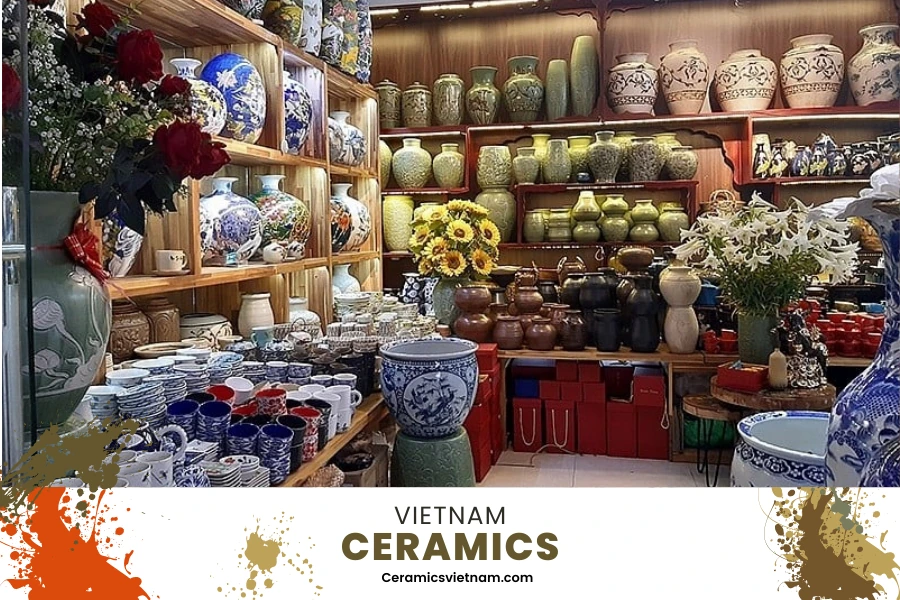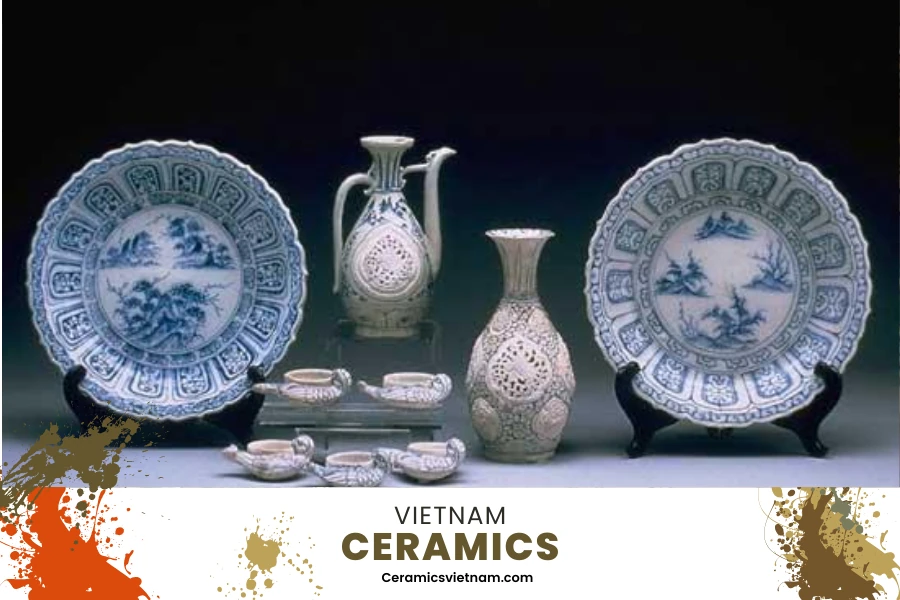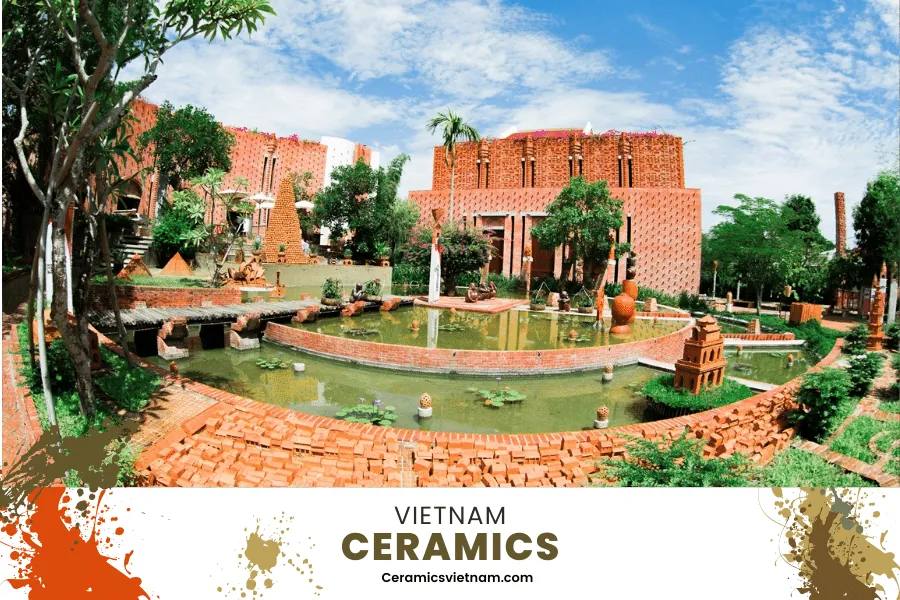Vietnam, renowned for its rich cultural heritage and artistic craftsmanship, boasts a vibrant ceramic tradition that continues to thrive in contemporary times. Delving into the landscape of Vietnamese ceramics unveils a tapestry woven with centuries-old techniques, innovative designs, and a deep-rooted cultural significance. Let’s embark on a journey to discover some of the most celebrated ceramic lines that adorn the artistic landscape of Vietnam today. Let’s find out with CeramicsVietNam in the article below
Ceramics hold a special place in the hearts of the Vietnamese people. Increasingly favored for their elegant beauty, intricate designs, and high safety standards, ceramics have become a beloved choice for many.
Throughout history, the art of ceramics in Vietnam has flourished since ancient times, dating back to the 1st century with ancient kilns in Tam Tho (Thanh Hoa), Dai Lai, Luy Lau, Duong Xa (Bac Ninh), Thanh Lang, Lung Ngoai, and Dong Dau (Vinh Phuc). Artisans during this period skillfully combined the Dong Son ceramic tradition with advanced production techniques from contemporary China to create a unique line of ceramics imbued with indigenous characteristics.
By the late 14th century, jade-glazed ceramics (“Ly dynasty ceramics” from the 11th to 13th centuries) and brown flower ceramics (“Tran dynasty ceramics” from the 13th to 14th centuries) gradually gave way to blue flower ceramics, introducing new materials and artistic styles. Blue flower ceramics mark the third milestone in the historical development of ancient Vietnamese ceramics, both in terms of technical advancement and decorative art, following two renowned lines of ceramics: jade-glazed and brown flower. Vietnam has become one of the rare countries in the world capable of producing such high-quality ceramics.
Despite the ups and downs of the nation’s history, Vietnamese ceramics have persisted and flourished, enriching daily life in numerous ways. Join Quan Tra as we explore some of the most famous ceramic lines in Vietnam today
Bat Trang Ceramics (Gia Lam District, Hanoi)

Learn about famous ceramic lines in Vietnam today
Bat Trang ceramics is one of the most renowned ceramic lines in Vietnam, known for its prestige and tradition that endure to this day.
The Bat Trang pottery village emerged around the 15th century, situated beside the fertile Red River. At that time, Bat Trang was a high mound of land near the river, providing ideal conditions for pottery making and transportation.
Despite various upheavals, the ancient pottery village has steadfastly endured and continues to thrive. Today, Bat Trang village is located in Bat Trang commune, Gia Lam district, Hanoi.
Determined not to let their craft succumb to the passage of time, the people of Bat Trang village have continuously learned and innovated, producing increasingly diverse products to meet market demands. Over time, Bat Trang ceramics have maintained their classic glazes, with shaping processes done entirely by hand, resulting in sturdy and finely crafted ceramic structures. The distinctive glaze often features a milky, translucent hue, with some unique glazes such as green glaze and crackled glaze found only in Bat Trang.
While focusing on the restoration of ancient feudal artifacts, Bat Trang ceramics also emphasize the development of quality and design, continuously expanding their reach and exporting to European and Asian countries. Today, Bat Trang ceramics stand as the most sustainable traditional craft village and brand in Vietnam.
Chu Dau Ceramics (Nam Sach District, Hai Duong)

Learn about famous ceramic lines in Vietnam today
This is one of the earliest pottery villages in Vietnam, located in Thai Tan commune, Nam Sach district, Hai Duong province. Chu Dau ceramics originated in the 13th century and flourished from the 14th century, regarded as the most sophisticated ancient ceramics in Vietnam. Unfortunately, due to wars and turmoil in the 17th century, this pottery village declined and its techniques were lost.
Until 2001, efforts were made to research and restore the techniques, glazes, and designs of Chu Dau ceramics. Gradually, the village regained its strength and rewrote its golden era.
Deeply influenced by Buddhist and Confucian values, it is not difficult to find the imprint of Buddhism and the teachings of Lao Tzu in the art of Chu Dau ceramics. This is considered a distinctive feature of the artisans here compared to those in other pottery villages.
The clay used for ceramics here is from the white clay of Truc Thon, Chí Linh town, Hai Duong province. To achieve pure whiteness, artisans have to mix and filter the clay with water before the pottery-making process.
Therefore, Chu Dau ceramics have a very pure white glaze. Blue patterns are created by using white glaze mixed with cobalt. Brown-red, green, and yellow patterns are achieved through the use of three-colored glazes. The designs and patterns are expressed in various forms such as painting, carving, engraving, and embossing, all of which are generous and sincere
Phu Lang Ceramics (Que Vo District, Bac Ninh)
Phu Lang pottery village is located in Que Vo district, Bac Ninh province. It has a similar formation and development process to Bat Trang village. However, the products of Phu Lang ceramics mainly consist of household items made from red clay and are handcrafted on a pottery wheel.
Phu Lang ceramics are known for their brown, dark brown, light yellow, and deep yellow glazes, often referred to as mottled glazes. This characteristic sets Phu Lang apart from other pottery villages in Vietnam.
Moreover, the craftsmanship of the artisans is also distinctive. They use the embossed technique with ball stamping. The natural glaze colors are long-lasting and unique. The designs are simple, sturdy, and deeply rooted in local culture
Thanh Ha Ceramic (Hoi An City, Quang Nam Province)

Pottery Village of Thanh Ha, Hoi An
A familiar name in the hearts of Vietnamese people, “Thanh Ha Ceramic” is renowned not only for its beautiful glazes but also for the lightweight of its products.
Born later than Phu Lang, with a history of about 500 years, Thanh Ha pottery village located in Hoi An is still famous for its durable clay products.
Using local materials, artisans extract brown clay along the Thu Bon River as the main material. This type of brown clay is highly plastic and adhesive.
Compared to similar items from other regions and brands, Thanh Ha ceramics feel significantly lighter when held. The special feature of this product line lies in being made from brown clay extracted along the Thu Bon River, which is soft, pliable, and highly adhesive. This craft village usually produces familiar household items such as bowls, plates, and plant pots, quickly becoming a popular choice for Vietnamese consumers. Most of the products from Thanh Ha village feature deep orange, light red-brown, and porous bone glazes, with intricate carving and decoration.
Bau Truc Ceramic (Binh Thuan)

Learn about famous ceramic lines in Vietnam today
Bau Truc pottery village is the ceramic village of the Cham people and is among the oldest in Southeast Asia. Cham ceramics once reached the pinnacle of pottery culture, as evidenced by numerous excavated relics.
As a brand bearing the exclusive style of the Champa land, Bau Truc pottery village has not been swayed by contemporary trends that may fade its traditional colors. It still chooses to preserve traditional hues such as red gold, pink, brown streaks, etc., combined with patterns deeply rooted in rural life such as herons, storks, rivers, and lakes. Bau Truc ceramic is the choice for those who appreciate nostalgia and meticulous craftsmanship. Bau Truc ceramics are highly regarded for their simplicity, lightness, and rustic charm in design.
Bau Truc pottery is unglazed and carries a strong indigenous culture. Carved patterns depict river lines, shellfish dots, simple nail patterns, familiar and rustic. The ceramic products have an earthy bone color and unevenness due to excessive firing that causes charring. Moreover, Bau Truc pottery is not fired in kilns but outdoors using wood and straw at temperatures ranging from 700 to 900 degrees Celsius.
Binh Duong Ceramic (Lai Thieu Pottery, Tan Phuoc Khanh, Thu Dau Mot)

Learn about famous ceramic lines in Vietnam today
Lai Thieu Pottery Village – Tan Phuoc Khanh – Thu Dau Mot (Binh Duong) inherits the essence of Mai Tree ceramics in the late 19th century. Thanks to the abundant clay soil and ample firewood resources, the pottery village was formed.
However, nowadays, Lai Thieu Pottery Village no longer exists. Instead, there is development on an industrial scale and in accordance with market trends. Therefore, the old traces of Lai Thieu pottery village are almost non-existent. During its heyday, all products were handmade and fired in traditional wood-fired kilns. The remnants only indicate that Lai Thieu pottery mainly served daily life in the Southeast region.
Regarded as a cluster of pottery villages, many major brands from other countries are also competing to build and establish factories in Binh Duong. The Lai Thieu – Tan Phuoc Khanh – Thu Dau Mot pottery villages are gradually asserting their reputation. With the goal of serving domestic consumers and continuously improving skills to achieve the dream of exporting abroad, Binh Duong pottery village is gradually transforming itself strongly, contributing to the country’s development while preserving the traditional cultural values of our ancestors.
Bien Hoa Ceramic (Dong Nai)
Some opinions suggest that the pottery craft in Bien Hoa dates back to the time when Vietnamese people from Thuan Quang migrated to the Southern region and brought along their traditional craft to serve their livelihoods. The traces of pottery kilns established by people from the Central region are still visible in the pottery kilns along the Pho Island, also known as the Mieng Sanh wharf. Another opinion states that the pottery craft in Bien Hoa originated in the 17th century when settlers from Guangdong, led by Tran Thuong Xuyen, established themselves on Pho Island in 1679.
It wasn’t until the early 20th century, with the establishment of the Bien Hoa School of Crafts (now the Dong Nai College of Decorative Arts), that Dong Nai ceramics truly emerged. In 1923, when Mr. Robert Balick (a graduate of the Paris School of Decorative Arts) became the principal and his wife, Mrs. Mariette Balick (a graduate of the Limoges Pottery School), became his assistant, the school shifted its focus to primarily train and teach pottery making.
The ceramic products of the school became increasingly renowned both domestically and internationally, receiving medals from the French government when participating in the Paris International Fair in 1925 and shaping the Bien Hoa ceramics, differentiating them from other long-standing ceramic styles like Mai Tree ceramics and Lai Thieu ceramics.
Bien Hoa ceramics are made from kaolin and colored clay. The main products include pots, elephants, animals, and statues. Unlike the pottery villages in the Red River Delta, Bien Hoa pottery is famous for its relief carving and enamel painting combined with colored glazes, creating unique and sophisticated products.
Furthermore, Bien Hoa ceramics are lightweight, with ivory-colored clay. The potters do not fire the ceramics at high temperatures like in other Vietnamese pottery villages. They only lightly fire them over flames to maintain the original appearance of the ceramic color. At the end of the 18th century, when Pho Island was devastated, some potters moved to Cho Lon to produce Mai Tree ceramics, while others went to Tan Van to establish the Tan Van pottery village.












Leave a reply